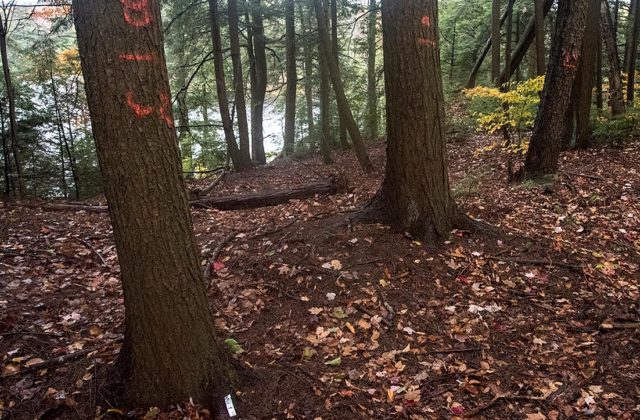Great Mountain Forest Makes Long-Term Deal to Sell Carbon Credits
Planning for the Future
By Tom Vorenberg
Early one morning last month a young man and his girlfriend, visiting Norfolk from a western state, hiked up the logging road from the Great Mountain Forest (GMF) east gate. They wanted to get to the pond known as Old Man Mac to watch the sunrise. It was a crisp morning, and the rising sun slowly revealed a tapestry of reds, yellows and greens—the same view that had greeted the young man’s parents on a similar morning 30 years earlier, and greeted his grandparents and his great-grandparents during their courtships two and three generations back.
As part of its efforts to preserve and protect this legacy, GMF announced at the annual meeting of its board of trustees in September that it has entered into an agreement with the private-investment fund Climate Trust Capital to assess the amount of stored carbon in the forest’s 6,000 acres in order to generate what are known as carbon credits. The money from the sale of these carbon credits will go into the foundation’s endowment.
GMF is one of many land preservation 501(c)3 foundations in the United States. Like other not-for-profit organizations, the key to GMF’s covering its $500,000 annual operating costs is its robust fundraising efforts, which work to close the gap left after the draw off the endowment. The substantial increase to GMF’s endowment predicted by the agreement with Climate Trust Capital will generate additional funds to help meet the operating costs.
The basic idea behind carbon credits is that companies that generate more carbon dioxide (CO2) than others can purchase credits (or offsets) from companies that pollute less. The GMF board had discussed the idea of marketing its stored carbon in the past, but a recent extension of a California law capping how much carbon each company in that state is allowed to produce every year spurred the present deal. California companies are now forced to look elsewhere to find carbon credits so they can stay in business in their state.
New England forests have some of the highest rates of carbon storage in the United States. In the 1980s GMF set up carbon flux towers to measure how much carbon its forest pulls down out of the air and stores in its biomass. In addition, New England forests are more desirable for companies seeking to buy carbon credits because they do not burn as often as forests elsewhere in the country.
As part of the agreement, GMF agreed to engage in the preservation and management of a healthy forest for the next 100 years. Third-party foresters will review random sections of the forest every six years to ensure that GMF is keeping up its end of the bargain.
Speaking about the deal at the annual meeting, keynote speaker and former GMF executive director Hans Carlson said that “while the word legacy implies a look into the past, in GMF’s case the legacy was always to do right by the land in the past and in the future, which has paid off in the organization going forward. This deal will continue to do the right thing for the land, with tangible and meaningful benefits.”
GMF board member Charlie Canham, a senior scientist at the Cary Institute of Ecosystem Studies in Millbrook, N.Y., was actively engaged in putting together the sale of GMF’s carbon credits. He calls GMF is a model of “skilled resource management.” He feels that this deal between Climate Trust Capital and GMF offers “a way to compensate landowners for the valuable service they provide to the earth by offsetting CO2 emissions while also providing a valuable resource for education, recreation and, simply, natural beauty.”
The annual meeting of the GMF board closed with an emphasis on how the sale of carbon credits by GMF will provide other landowning foundations with a model of sustainability and help fund its mission-driven vision. But on a more individual level, it means that the young man and his girlfriend can rest assured that subsequent generations of his family and the families of all area residents can keep hiking to Old Man Mac to take in the same fall tableau as their ancestors.
Photo by Bruce Frisch: Throughout Great Mountain Forest are 150 carbon plots, circles of trees that have been painted and tallied for species, size and condition. These will be monitored on a six-year basis to maintain a running inventory of the forest’s biomass.

